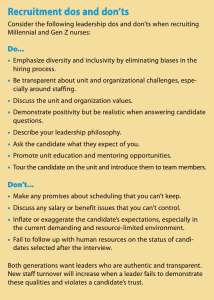Take into account generational and individual preferences to support retention.
For years, Cal, a critical care director in a well-known academic medical center, had waiting lists of nurses anxious to become part of his team. Not anymore. For the first time in his leadership career, Cal must actively recruit nurses. Most of his candidates are either Millennial or Generation Z nurses, and they seem less interested in the medical center brand and more interested in how a position in his unit will fit their career trajectory. Nurse recruitment has changed, and Cal must adapt how he markets his department and team to potential new hires.
Across the United States, nurse leaders like Cal face a serious nurse shortage. Nurse turnover has increased significantly, and many nurses are cutting their hours to achieve a better work–life balance. The COVID-19 pandemic has changed how nurses view their work and career plans. The 2022 nursing workforce differs notably from 2019, with most new acute care staff members in the Millennial or Gen Z cohorts. This trend will continue as Baby Boomers exit the profession over the next 5 years.
Healthcare organizations like Cal’s find themselves in a highly competitive recruitment landscape. Because many Millennial and Gen Z nurses have different expectations of employers than previous generations, being a brand-name medical center no longer makes it an employer of choice. Cal recognizes that the recruitment strategies he used in the past may not be effective now.
A changing recruitment landscape
Workforce experts have sounded the alarm about the tight nursing labor market. With 500,000 additional retirements expected over the next 2 years, the U.S. Department of Labor predicts a shortfall of over one million nurses, forcing managers like Cal to compete with others for a shrinking number of applicants. Becoming an employer of choice has never been more critical or challenging. Most applicants today have little or no nursing experience, and a new graduate who accepts a position in critical care is unlikely to spend more than 2 years in the role. According to Hoffman and colleagues, many young nurses view their careers in terms of tours of duty rather than lifetime employment, and they expect managers to coach them to achieve their professional goals.
Cal must learn how to persuade applicants that his critical care unit can help them achieve career growth. Discussing salary and benefits may not be enough. Gallup researchers recommend that organizations commit to nurse well-being that extends beyond physical and psychological wellness. As nurses weigh their work options, they’re considering student loan debt, affordable housing, and childcare.
To aid his recruitment efforts, Cal should use social media sites, such as Instagram and YouTube, and ensure candidates can apply using mobile devices. The current job market requires interviewing and job offer speed. Cal should work closely with human resources (HR) to ensure that high-value candidates aren’t lost in a bureaucratic hiring process.
What matters to Millennial and Gen Z nurses
Similarities and differences exist between these generations. For Millennial nurses, Cal should prepare to discuss the unit’s vision and how he leads nurses to contribute positively to society. His approach to teamwork should focus on diversity and inclusivity. Anselmo-Witzel and colleagues report that most Millennial nurses want leaders to support their ongoing education and enhance their self-empowerment. Many members of this generation value achieving higher education, work–life balance, and working in various environments.
Hampton and colleagues describe Gen Z nurses as altruistic, socially motivated, and community oriented. Cal needs to strategize how best to incorporate team activities and opportunities for social engagement among staff. Gen Z nurses expect a flexible and creative benefits package that might include options for higher education and meal plans. This generation of nurses values financial stability, so Cal should describe how the organization’s structures help achieve this.
For both generations, Cal must create a welcoming environment that’s not just open to career path growth but has actionable plans—such as unit mentorship programs—that support nurses. These opportunities can help mitigate job hopping that sometimes occurs among Millennials and also encourage Gen Z nurses to engage in different roles.
Both generations value technology and accommodating work schedules. Cal can make the unit more inviting by touring candidates through the intensive care unit and highlighting patient care technology. He also can emphasize staff involvement in scheduling to reassure potential new hires that their preferences will be considered. (See Recruitment dos and don’ts.)


Recruit for retention
How you manage recruitment sets the stage for how a nurse views long-term employment with an organization. As Cal interviews candidates, he should use the following strategies, which can directly impact long-term retention.
Interview every candidate personally
As tempting as it might be to delegate the time-consuming hiring process, remember that retention begins with recruitment. Nurse leaders like Cal are the linchpins in nurse recruitment and retention. Cal should play a hands-on role rather than delegating interviewing to a nurse recruiter or HR. He should meet every candidate personally, either in person or virtually, and remember that candidates will be interviewing him while he’s interviewing them. According to Shah and colleagues, dissatisfaction with an immediate supervisor places in the top five reasons why nurses leave their jobs. Nurses want a good relationship with their leader, and that starts at the first interview.
Set expectations
Nurses frequently leave positions that aren’t what they expected. Discussing expectations during the interview can eliminate some of this dissatisfaction. Many Gen Z nurses may not have worked in high school or college, so their first nursing position is literally their first job. Cal will want to talk about a professional culture of feedback, so new nurses know to expect input about what they need to start, stop, or continue doing. No job is Instagram perfect, so discussing the pros and cons of critical care nursing positions can help recruits know what to anticipate. During the interview, Cal can explain professionalism and ask every candidate what they expect from him.
Consider job embeddedness
You can’t always predict why some nurses stay and others leave, but job embeddedness—the factors that keep a nurse on the job and make it difficult to leave a position because of the sacrifices involved—can aid retention. Job embeddedness factors include links the nurse might already have to the unit, such as a best friend at work or student practicum experiences in the department. Job embeddedness also occurs when the nurse’s values are congruent with the organization’s. Cal’s hospital also might have benefits—such as childcare—that make it hard to leave.
Discuss the onboarding process
Dissatisfaction with employment can start when new staff members feel that they’ve received a poor unit orientation. Cal should address these concerns by clearly laying out the hospital and unit orientation process. He also should describe what follow-up he does with new employees during their first 90 days to ensure a smooth transition.
Begin career coaching
Retention efforts should occur at the unit and system levels to ensure that a nurse’s “tours of duty” are within a single organization. As Cal talks about his unit during the recruitment process, he should discuss career opportunities across the organization. Doing this as part of the interview process demonstrates a high priority on career mobility.
Discuss next steps
Candidates should leave the interview clearly understanding the next steps in the recruitment process. If Cal interviews a candidate he wants to hire, he should make sure they have his contact information for any further questions and to follow up if they don’t hear back in the expected timeframe. When a nurse is hired, Cal should continue to stay in touch, especially if a gap occurs between the interview and the planned start date.
Make it a good experience
In an environment where nurses are in short supply, nurse leaders should use everything in their circle of influence to recruit and retain staff. Cal is the chief recruitment officer for his unit, so he should understand and use recruitment best practices. Nurse leaders must think of themselves as organizational ambassadors. Even if a candidate doesn’t accept a position or isn’t selected, they’ll remember how you made them feel. Strive to leave a good impression even when the candidate isn’t a good fit for the unit or isn’t interested in the job. Gen Z and Millennial nurses are likely to share their experiences on social media, so make the recruitment experience a positive one.
Rose O. Sherman is an adjunct professor at the Marian K. Shaughnessy Nurse Leadership Academy, Case Western Reserve University in Cleveland, Ohio, and author of The Nuts and Bolts of Nursing Leadership: Your Toolkit for Success and The Nurse Leader Coach: Become the Boss No One Wants to Leave. You can read her blog at emergingrnleader.com. Tanya M. Cohn is an associate professor of practice and a consulting nurse scientist at Simmons University in Boston, Massachusetts.
References:
Anselmo-Witzel S, Heitner KL, Dimitroff LJ. Retaining generation Y nurses: Preferred characteristics of their nurse managers. J Nurs Adm. 2020;50(10):508-14. doi:10.1097/NNA.0000000000000926
Clifton J, Harter J. Wellbeing at Work: How to Build Resilient and Thriving Teams. New York, NY: Gallup Press; 2021.
Greenberg A. 15 strategies for recruiting Millennial and Gen Z candidates. ContractRecruiter. June 12, 2021.
Hampton D, Welsh D. Work values of Generation Z nurses. J Nurs Adm. 2019;49(10):480-6. doi:10.1097/NNA.0000000000000791
Hoffman R, Casnocha B, Yeh C. Tours of duty: The new employer-employee contract. Harvard Business Review. June 2013.
Horovitz B. 10 tips for hiring—and retaining—Gen Z employees. SHRM. January 13, 2021.
Jacobs A. ‘Nursing is in crisis’: Staff shortages put patients at risk. The New York Times. October 20, 2021.
Shah MK, Gandrakota N, Cimiotti JP, Ghose N, Moore M, Ali MK. Prevalence of and factors associated with nurse burnout in the US. JAMA Netw Open. 2021;4(2):e2036469. doi:10.1001/jamanetworkopen.2020.36469
Smiley RA, Ruttinger C, Oliveira CM, et al. The 2020 National Nursing Workforce survey. J Nurs Regul. 2021;12(1):S1-96.


















